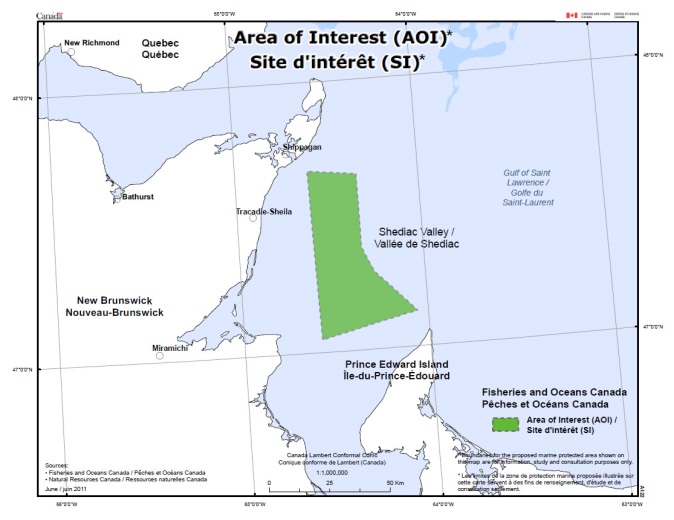Shediac Valley Area of Interest (AOI)
Note:
The maps, diagrams and coordinates on this website are provided for general information and are not to be used for fishing, navigation and other purposes. Please contact your regional DFO office for official coordinates.
Note:
This area of interest is currently being re-evaluated in the context of a marine protected area network for the Gulf of St. Lawrence Bioregion.
Location
Location
The Shediac Valley is located in the Gulf of St. Lawrence, east of New Brunswick and north-west of Prince Edward Island. It covers an area of approximately 1,530 km2.
There are two existing fishery closures which overlap with part of the Area of Interest (AOI): a gillnet closure and a groundfish closure. The closures are aimed at protecting American Plaice, Greenland Halibut, Atlantic Cod and Redfish.
Ecological Importance
Ecological Importance
The Shediac Valley Area of Interest is recognized as having high productivity with circular currents located near the north and south borders. Water depths in the AOI range from 24 to 51 meters.
The area is a key habitat in the life cycle (feeding, refuge, nursery and spawning) of various fish, including many commercial species. In particular, it is used by Atlantic Cod as a summer feeding, spawning and nursery area. Other species such as the American Plaice and the Winter Skate are also present in the area.
Key Objectives and Approach
Key Objectives and Approach
Shediac Valley was announced as an Area of Interest for an Oceans Act Marine Protected Area (MPA) in June 2011.
The objective of the proposed MPA is to ensure that unique features of the Area, which make it appropriate for aggregation and/or that ensure the reproduction and survival of the species in that area, are not altered by human activities.
The MPA designation process will include public input to determine the costs and benefits of MPA designation. The AOI will undergo a detailed biophysical and socio-economic evaluation and public consultations before a decision is made to formally designate it as a Marine Protected Area. Open, inclusive consultation will improve understanding of the designation process and clarify the roles and opportunities to participate for all sectors. Consultation with First Nations, stakeholders, industry and interested groups will also provide opportunities to contribute to the evaluation and analysis of impacts of MPA designation, establishment of appropriate conservation and management objectives, and development of the regulatory package.
- Date modified:
